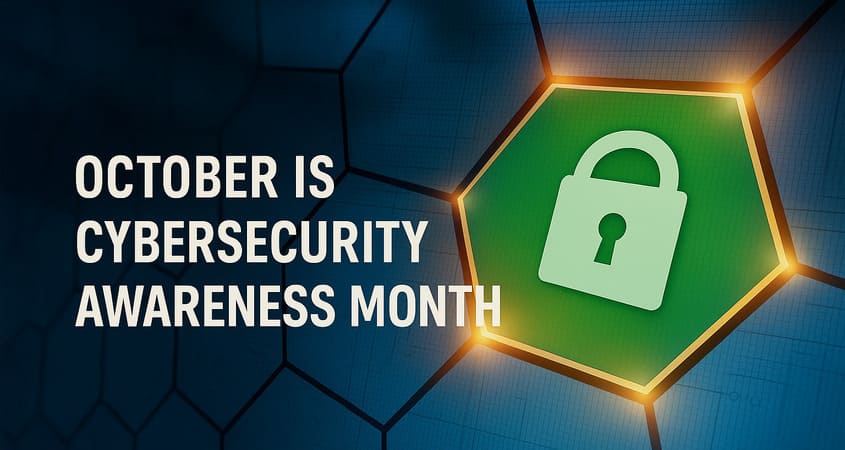October is Cybersecurity Awareness Month – Why Does It Matter for Your Business?

Cybersecurity has long ceased to be a purely technical matter and has become a strategic element of every organization’s operations – regardless of its size or industry. The growing scale of attacks, increasingly sophisticated techniques used by cybercriminals, and global digitalization make resilience against cyber threats one of the key factors of competitive advantage.
October is a special month in this context – in Europe we celebrate the European Cybersecurity Month (ECSM), and in the United States the Cybersecurity Awareness Month. This is an annual, international initiative dedicated to education, awareness, and practical actions related to protecting against digital threats.
Table of Contents
ToggleHistory and Origins of the Initiative
The first Cybersecurity Awareness Month was launched in 2004 in the US, in cooperation with the National Cyber Security Alliance (NCSA) and the Department of Homeland Security (DHS). In Europe, the initiative appeared in 2012 under the auspices of ENISA (European Union Agency for Cybersecurity) and the European Commission.
From the very beginning, the objectives were clear:
- increasing awareness among citizens and businesses,
- promoting best practices in data protection,
- educating employees and managers,
- strengthening the security culture in both the private and public sector.
Each year, ECSM is implemented under a specific theme, focusing attention on the most important threats and recommended actions.
EU and ENISA Initiatives
ENISA plays a key role in promoting cyber resilience in Europe. As part of ECSM, the following activities are carried out:
- educational campaigns aimed at citizens, businesses, and the public sector,
- webinars and training on new technologies and cybersecurity trends,
- publication of reports and guidelines on supply chain security, critical infrastructure protection, incident management,
- simulation exercises (cyber ranges) involving EU institutions and private companies,
- legislative initiatives (e.g., the NIS2 Directive), raising minimum security standards for essential service operators and digital infrastructure providers.
ECSM is not just a marketing campaign – it represents real actions that enhance organizational maturity in information security.
Modern Threats – Why Awareness Is Crucial?
The year 2025 brings new challenges in cybersecurity. Here are some examples of attacks and trends illustrating the scale of the problem:
1. Phishing and Spear Phishing
- Over 80% of all security incidents start with a malicious email.
- Artificial intelligence (AI) is increasingly used to generate realistic, error-free, and contextually personalized messages.
2. Ransomware-as-a-Service (RaaS)
- Criminal groups offer “ready-to-use” encryption tools as a service.
- The cost of recovering data after such an attack often exceeds millions of euros.
3. Supply Chain Attacks
- Example: the high-profile SolarWinds incident, which affected hundreds of organizations worldwide.
- SMEs are increasingly targeted as subcontractors of larger companies.
4. Deepfakes and AI-driven Social Engineering
- Fake audio and video recordings are used to extort funds or manipulate corporate reputation.
5. Next-Generation DDoS Attacks
- Increasingly powerful IoT botnets can paralyze e-commerce operations or financial portals.
6. Cloud Misconfigurations
- Improperly secured resources in AWS, Azure, or Google Cloud are a common attack vector.
Why Should Your Company Pay Attention to ECSM?
Awareness and prevention are far less costly than responding to incidents. IBM Cybersecurity research shows that the average cost of a data breach in 2024 was USD 4.45 million.
Participation in ECSM initiatives offers companies the opportunity to:
- educate employees in cyber hygiene,
- implement simple yet effective defense mechanisms (MFA, password policies, system updates),
- deploy SSL/TLS certificates as the foundation of online trust,
- learn and implement ENISA and NIS2 recommendations,
- gain competitive advantage through a proactive approach to customer data security.
Examples of Real Incidents in Europe and Worldwide
- Colonial Pipeline (2021) – a ransomware attack paralyzed fuel supplies in the US.
- Vastaamo (2020) – data breach of a Finnish psychotherapy clinic, including confidential therapy notes.
- Hospital Attacks in Ireland and France – ransomware extortion and disruption of critical infrastructure.
- Lapsus$ Group (2022–2023) – teenagers using social engineering to breach tech giants (Microsoft, NVIDIA, Samsung).
Each of these incidents shows that not only large corporations but also SMEs can become targets due to their limited security resources.
Summary
October, as Cybersecurity Month, is the perfect opportunity for companies to implement or review security policies and remind employees that cyber protection is an ongoing process, not a one-time effort.
Organizations that invest in security – both at the technical level (SSL/TLS certificates, WAF, backups, monitoring) and at the organizational level (training, security policies, incident response plans) – gain not only peace of mind but also a competitive advantage.
👉 At HEXSSL, we support companies in building trust and protecting data through SSL/TLS certificates, audits, and solutions that enhance online security and credibility. October is the best time to put cybersecurity at the center of attention – before a cybercriminal does it for us. Have questions about your company’s security? Contact our sales team.
